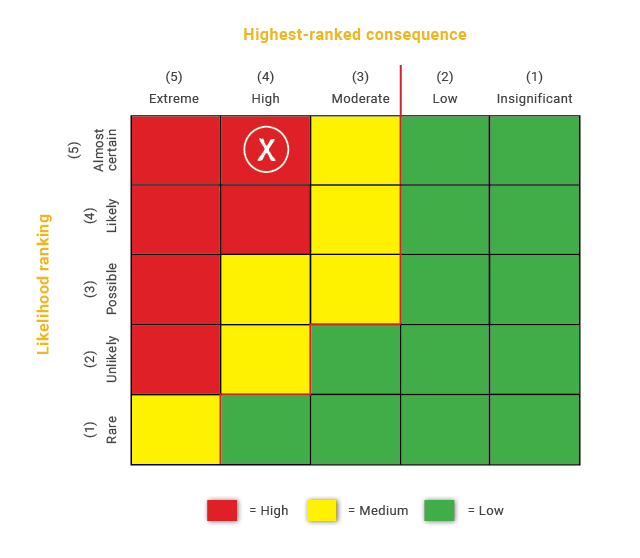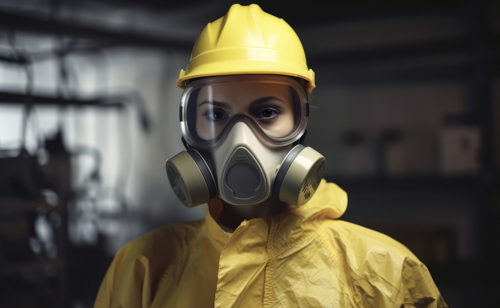Safety risk management: How to identify and control hazards in the workplace
While some workplace health and safety hazards are easy to identify, like chemical spills or potential misuse of heavy machinery, others aren’t so obvious. Rather than waiting for incidents to occur due to hidden health and safety hazards, be proactive in your safety risk management.
Your risk management needs to be planned, systematic and cover all reasonably foreseeable health and safety hazards and associated risks. This allows you to respond and facilitate changes immediately to ensure a safe work environment for your business.
Effectively manage work, health and safety (WHS) risks
The four steps of a WHS risk management process are:
- Step 1: Identify hazards – What could potentially cause harm?
- Step 2: Assess risks – How serious is the potential harm? What is the likelihood of it occurring?
- Step 3: Control risks – What’s the most effective control measure?
- Step 4: Review control measures – How often will you check the control measures to ensure they are working as planned?
Where are health and safety hazards likely to occur?
When considering potential health and safety hazards in your workplace, there are four different aspects to review:
- Physical work environment
- Equipment, materials and substances used
- Work tasks and how they are performed
- Work design and management
It’s vital to conduct your risk assessment across all areas for a thorough understanding of the work environment.
Some common hazards to look out for:
- Manual handling – Overexertion or repetitive movement can cause muscular strain
- Falls and trip hazards – Falling objects, falls, slips and trips of people can cause fractures, bruises, lacerations, dislocations, concussion, permanent injuries or death
- Electricity – Exposure to live electrical wires can cause shock, burns or death from electrocution
- Machinery and equipment – Being hit by moving vehicles, or being caught by moving parts of machinery can cause fractures, bruises, lacerations, dislocations, permanent injuries or death
- Hazardous chemicals – Chemicals (such as acids, hydrocarbons, heavy metals) and dusts (such as asbestos and silica) can cause respiratory illnesses, cancers or dermatitis
- Extreme temperatures – Heat can cause burns, heat stroke or fatigue. Cold can cause hypothermia or frost bite.
- Noise – Exposure to loud noise can cause permanent hearing damage
- Radiation – Ultra violet, welding arc flashes, micro waves and lasers can cause burns, cancer or blindness
- Biological – Micro-organisms can cause hepatitis, legionnaires’ disease, Q fever, HIV/AIDS or allergies
- Psychosocial hazards – Effects of work-related stress, bullying, violence and work-related fatigue

How can I identify hazards in the workplace?
1. Inspect the work environment
The first step in identifying hazards is to regularly walk around the workplace and observe how people work, what chemicals and machinery are being used, and what safe and unsafe work practices are currently being implemented. Also consider what hazards may arise during machinery repair or shut down.
Can you see any potential health or safety hazards in the short and long term?
You may notice some obvious hazards, such as spillages, where action to protect workers can be taken immediately. Or you may notice a dangerous process, which could cause harm further down the track. Make a note of these workplace risks for risk control consideration later in the process.
2. Ask your workers
WHS is the responsibility of everyone – so it’s vital, as far as reasonably practicable, to ask your workers about any health and safety problems they’ve come across in their work. There might be some near misses or incidents that haven’t been reported as well.
Conducting workplace surveys are a good way to uncover information such as workplace bully or muscular aches.
3. Review available information
To find out more about potential workplace health and safety risks associated with your industry, seek information and advice from regulators, industry associations, unions, technical specialists, safety consultants and your health and safety representatives. Manufacturers and suppliers can also supply key information.
Looking closer to home, review your workplace’s records of workplace incidents, sick leave, and inspection and investigation reports to help identify potential further hazards.
How do I conduct a safety risk assessment?
To effectively implement control measures and manage risks, a safety risk assessment should be undertaken. A safety risk assessment helps determine the severity and likelihood of the hazard occurring and prioritise the type and immediacy of implementing control measures.
There is no formal safety risk assessment process – it can vary depending on the type of hazard and information and resources available to you.
The safety risk assessment template example below is from our Safety Management System documentation package. It uses a risk matrix to obtain an overall safety risk rating for each identified hazard to help prioritise a course of action.
The safety risk assessment involves three steps:
Step 1 – Determine the highest-ranked consequence
Decide the worst-case consequence for each identified hazard if there is a failure of existing control measures. (For example: the hazard could be handing hazardous substances and the worst-case-consequence could be skin corrosion). Choose a consequence rank for each category. The highest number is the highest-ranked consequence.
| Risk categories | Consequence rank and description | Worst-case consequence example: skin corrosion | |
| WHS harm | (1) Insignificant: (2) Low: (3) Moderate: (4) High: (5) Extreme: |
None or insignificant Minor injury not requiring medical attention Injury likely to require medical attention Injury likely to require hospitalisation Long-term injury or death |
(4) High |
| Legal noncompliance | (1) Insignificant: (2) Low: (3) Moderate: (4) High: (5) Extreme: |
Minor or none May result in a small fine May result in a large fine Possible lead to prosecution Probably lead to prosecution |
(3) Moderate |
| Corporate image | (1) Insignificant: (2) Low: (3) Moderate: (4) High: (5) Extreme: |
Minor or none May result in a small fine May result in a large fine Possible lead to prosecution Probably lead to prosecution |
(3) Moderate |
| Interested parties | (1) Insignificant: (2) Low: (3) Moderate: (4) High: (5) Extreme: |
No concern Minor concern Moderate concern Possible major concern Probable major concern |
(4) High |
| Cost | (1) Insignificant: (2) Low: (3) Moderate: (4) High: (5) Extreme: |
No cost Minor cost or up to 1 day off work Significant costs or up to 1 week off work Possible major cost or long-term off work Probable cost or loss of life |
(4) High |
Step 2 – Determine a likelihood ranking
Determine the likelihood of the worst-case consequence occurring if there is a failure of existing control measures.
| Likelihood ranking | Ranking descriptions |
| (1) Rare | Not ever expected to happen in the next 20 years |
| (2) Unlikely | May happen once or twice in the next 10 years |
| (3) Possible | Expected to happen once or twice a year |
| (4) Likely | Expected to happen each month on average |
| (5) Almost certain | Expected to happen most weeks |
Step 3 – Use a risk matrix to obtain a residual risk rating
Plot the highest-ranked consequence and likelihood ranking on the risk matrix to obtain a safety risk rating.

This hazard has a high safety risk rating. The highest level of protection is required.
How do I develop control measures?
Now you have conducted your risk assessment, the next step is to eliminate or reduce the risks, as far as reasonably practicable.
When considering control measures, consult with workers and their health and safety representatives affected by the risk and the decision. Their involvement will not only optimise the outcome but also increase the acceptance and use of the control measures.
You also need to consider if the control measure required is available (i.e. can be purchased, manufactured, or easily put in place) and suitable for your workplace’s circumstances (i.e. will work with the conditions, processes, and workers involved).
Most importantly, make sure that your chosen control measure does not introduce new hazards.
The hierarchy of control
An effective way for managing risks and, one that is required to be considered by duty holders, is working through the hierarchy of control.
The emphasis should be on eliminating hazards, especially hazards with the potential to cause death, serious injury, or illness. If that is not reasonably practicable then the next option is to minimise the risks using the alternatives in the hierarchy of control.
Here are the levels of the hierarchy of control:
- Elimination: Removing the hazard.
- Substitution: Replacing the hazard with something safer.
- Isolation: Keeping the hazard away from people.
- Engineering controls: Using physical control measures such as a mechanical device or process to manage risks.
- Administrative controls: Using systems of work and work procedures.
- Personal protective equipment (PPE): Providing the most appropriate protective equipment for workers to use to reduce exposure to the hazard.
Administrative controls and PPE are the least effective control measures relying on human behaviour and supervision to reduce exposure to the hazard.

How do I implement control measures?
The control measures put into operation usually require changes to the way work is carried out. There might be new or modified equipment, new processes, different chemicals, and/or new personal protective equipment (PPE).
To ensure a smooth transition, the control measures should be supported with:
Work procedures – Develop a safe work procedure describing the task, identifying the hazards, and explaining how the task is to be performed to minimise risks.
Training, instruction and information – Ensure your workers are trained in the new work procedure, so they understand what’s involved and can perform the task safely. Instruction and information may also need to be provided to contractors, customers, or visitors.
Supervision – The level of supervision required will depend on the level of risk and experience of the workers involved.
How do I manage the health and safety risks and control measures going forward?
The new control measures put in place should be reviewed regularly. Be aware of any new hazards that arise and take action immediately. Don’t wait until something goes wrong.
Keep records of your risk management processes as it will help each time you need to implement it, provide evidence of due diligence in the event of prosecution, assist with the development of new safe work procedures and assist with training.